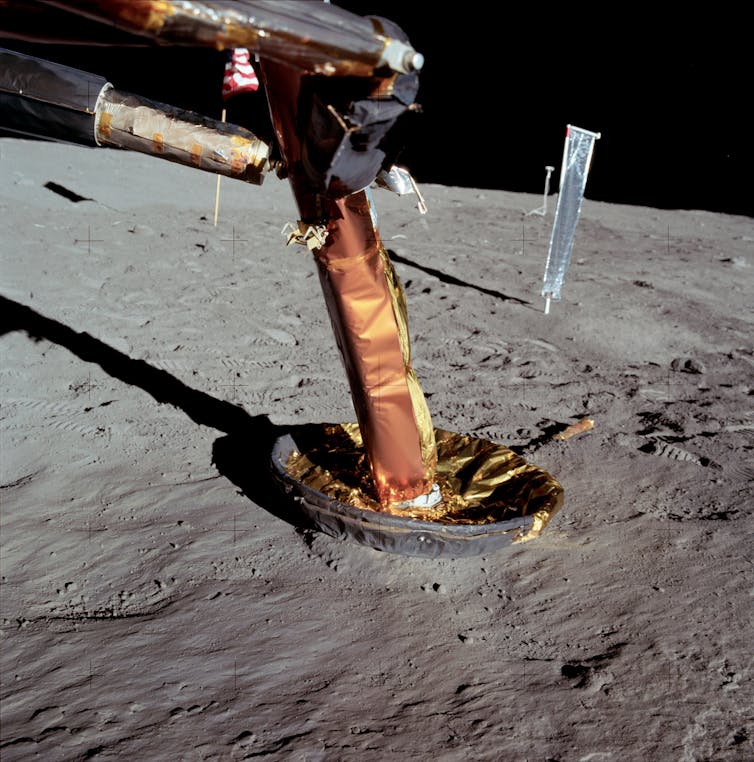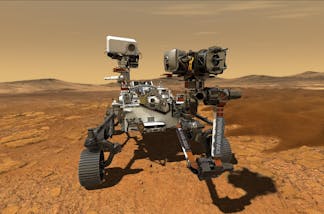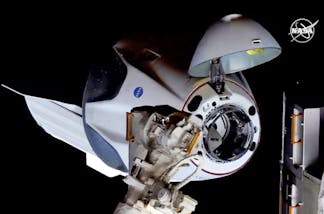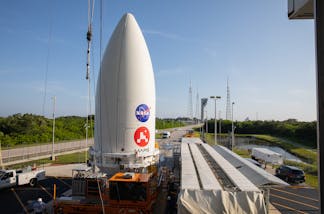Republican Convention Ignored Climate Threat, But Americans’ Attitudes Are Shifting
Many Americans have experienced climate-fueled disasters in the last four years and want to see federal action
By Scott Waldman, E&E News on August 28, 2020
 President Donald Trump looks on after delivering his acceptance speech for the Republican Party nomination for reelection during the final day of the Republican National Convention at the South Lawn of the White House in Washington, DC on August 27, 2020. Credit: Brendan Smialowski Getty Images
President Donald Trump looks on after delivering his acceptance speech for the Republican Party nomination for reelection during the final day of the Republican National Convention at the South Lawn of the White House in Washington, DC on August 27, 2020. Credit: Brendan Smialowski Getty ImagesIn four days of speeches lasting more than eight hours at the Republican National Convention, climate change was never mentioned as a threat to the country.
That silence stands apart from the climate alarm bells that have been sounding since Donald Trump accepted his first nomination for president four years ago.
Thousands of Americans have been killed in natural disasters such as hurricanes and wildfires during Trump’s first term in office. Each of those four years has been among the world’s hottest on record. Leaders of other nations have taken action as the United States ignores the issue.
Even Wall Street has begun to take notice of how climate change could affect economic growth.
None of that was apparent during the convention. Instead, Republican speakers insisted that the real concern was the climate ideas presented by Democrats. Many experts say that if climate change is left unanswered, it could cost trillions of dollars to the U.S. economy. Republicans said the real costs would come from Democratic plans to restrain the use of fossil fuels.
“Biden has promised to abolish the production of American oil, coal, shale and natural gas—laying waste to the economies of Pennsylvania, Ohio, Texas, North Dakota, Oklahoma, Colorado and New Mexico,” Trump said. “Millions of jobs will be lost, and energy prices will soar.”
(Biden’s plan does not call for a fracking ban).
Those sentiments play well with Trump’s core supporters, but they’re askew from what most voters believe, including younger Republicans, according to polls. They don’t reflect the events that many Americans are either experiencing or seeing online: uncontrolled wildfires in California and the strongest hurricane to hit Louisiana in 160 years.
Even as an unrelinquishing pandemic has killed more than 180,000 people in the United States and kept millions of children across the country from returning to school, climate change remains on the minds of voters, polls show.
Here are five climate themes that have advanced since Trump accepted his first nomination in 2016.
NATURAL DISASTERS
More than 3,000 Americans have died in natural catastrophes during the past four years; most of them were victims of Hurricane Maria in 2017.
The massive Category 5 storm killed an estimated 2,975 people in Puerto Rico and forced thousands to flee the U.S. territory. The devastation continues to have ripple effects three years later. Tens of thousands of people still live under leaky blue tarps. The island’s power supply, never reliable to begin with, has become far worse, and some parts of Puerto Rico were without power for a year.
That was the same year that Hurricane Harvey dumped 60 inches of rain on parts of Houston, becoming the wettest cyclone on record. Tens of thousands of homes were damaged, and about 70 people were killed. Harvey caused more than $100 billion in damage, making it one of the costliest disasters to strike the United States.
Record wildfires have also burned across the West. The 2018 Camp Fire in California was the deadliest; it killed 85 people and destroyed more than 10,000 homes. It was fueled by drought, an outcome of climate change. This week, California continued to battle the second- and third-largest wildfires in state history. Officials have connected the fires to climate change.
“All but three of the Top 20 Largest #Wildfires have occurred since 2000, with 10 of these large and damaging wildfires occurring in the last decade,” the California Department of Forestry and Fire Protection tweeted yesterday. “As fire weather continues to become more extreme, California is adjusting to fight these larger and more destructive wildfires.”
HEAT
The Trump years have been some of the hottest since record-keeping began after the Civil War, according to NASA. After a record-warm July, this year may break the all-time annual heat record set in 2016.
That’s a likely outcome, said Gavin Schmidt, director of the NASA Goddard Institute for Space Studies. That’s notable because four years ago, the record warmth was fueled by El Niño, a band of warm water covering the tropical Pacific Ocean. That influence is absent this year, Schmidt said, and long-term trends point to rising heat.
“We know that the trend is moving up; on average, every decade is warmer than the last,” he said. “The changes we’re seeing now are so far outside what would be possible in an un-globally-warmed world.”
“The COVID-19 pandemic has offered a unique opportunity to learn how people feel about climate change when faced with a global crisis,” said Ray Kopp, vice president of research and policy engagement at Resources for the Future.
“The claim that we can’t do anything about climate change without crashing the economy, or that we need to focus only on the pandemic and not do anything on climate right now, simply doesn’t resonate with Americans,” he said.
THE U.S. (AND EVERYONE ELSE)
Since Trump pledged to withdraw from the Paris climate agreement in 2017, world leaders have pressed him to rejoin and to take the issue seriously. Among them are German Chancellor Angela Merkel and French President Emmanuel Macron.
Last year, Trump said Prince Charles spent 90 minutes talking to him about climate change, trying to convince him to take stronger action and to once again make the United States a world leader. In response, Trump said he wanted “good climate,” but his administration has continued to roll back environmental safeguards meant to reduce emissions.
In December, Macron said other governments, including China, Russia and the European Union, would lead the world in reducing emissions.
The yearslong process of withdrawing from the Paris Agreement won’t be done until November. Yesterday, Biden tweeted that if he wins the election, he would rejoin the pact on the first day of his presidency.
CLIMATE HITS WALL STREET
This week, it was announced that Exxon Mobil Corp. would be dropped from the Dow Jones Industrial Average stock index. It’s a significant departure, as Exxon was the longest-tenured company on the Dow, having been listed for almost a century.
It’s also a reflection of how oil companies have taken a financial hit amid growing concerns about climate change and as a result of declining consumption due to the pandemic.
At the same time, some solar and wind companies have grown bigger than their fossil fuel competitors. The same factors that have weakened fossil fuel companies, including more aggressive climate targets, helped drive clean energy technologies.
On Wall Street, business interests are increasingly warning the Federal Reserve and other regulators that climate change could pose a significant risk to the economy.
Earlier this year, 40 investment firms and organizations that handle more than $1 trillion in assets urged Fed Chairman Jerome Powell to take action. They warned him that climate “threats have the potential to compound in ways we don’t yet understand, with disastrous impacts the likes of which we haven’t seen before.”
Reprinted from Climatewire with permission from E&E News. E&E provides daily coverage of essential energy and environmental news at www.eenews.net.
ABOUT THE AUTHOR(S)
Scott Waldman
Recent Articles
What Changed--and What Didn't--in Democrats' Climate Platform
Climate Denial Spreads on Facebook as Scientists Face Restrictions
Trump Waives Environmental Reviews, Vulnerable Communities Could Bear the Brunt
CLIMATE
What Climate Change Does to the Human Body
17 minutes ago — Neelu Tummala | Op
None of that was apparent during the convention. Instead, Republican speakers insisted that the real concern was the climate ideas presented by Democrats. Many experts say that if climate change is left unanswered, it could cost trillions of dollars to the U.S. economy. Republicans said the real costs would come from Democratic plans to restrain the use of fossil fuels.
“Biden has promised to abolish the production of American oil, coal, shale and natural gas—laying waste to the economies of Pennsylvania, Ohio, Texas, North Dakota, Oklahoma, Colorado and New Mexico,” Trump said. “Millions of jobs will be lost, and energy prices will soar.”
(Biden’s plan does not call for a fracking ban).
Those sentiments play well with Trump’s core supporters, but they’re askew from what most voters believe, including younger Republicans, according to polls. They don’t reflect the events that many Americans are either experiencing or seeing online: uncontrolled wildfires in California and the strongest hurricane to hit Louisiana in 160 years.
Even as an unrelinquishing pandemic has killed more than 180,000 people in the United States and kept millions of children across the country from returning to school, climate change remains on the minds of voters, polls show.
Here are five climate themes that have advanced since Trump accepted his first nomination in 2016.
NATURAL DISASTERS
More than 3,000 Americans have died in natural catastrophes during the past four years; most of them were victims of Hurricane Maria in 2017.
The massive Category 5 storm killed an estimated 2,975 people in Puerto Rico and forced thousands to flee the U.S. territory. The devastation continues to have ripple effects three years later. Tens of thousands of people still live under leaky blue tarps. The island’s power supply, never reliable to begin with, has become far worse, and some parts of Puerto Rico were without power for a year.
That was the same year that Hurricane Harvey dumped 60 inches of rain on parts of Houston, becoming the wettest cyclone on record. Tens of thousands of homes were damaged, and about 70 people were killed. Harvey caused more than $100 billion in damage, making it one of the costliest disasters to strike the United States.
Record wildfires have also burned across the West. The 2018 Camp Fire in California was the deadliest; it killed 85 people and destroyed more than 10,000 homes. It was fueled by drought, an outcome of climate change. This week, California continued to battle the second- and third-largest wildfires in state history. Officials have connected the fires to climate change.
“All but three of the Top 20 Largest #Wildfires have occurred since 2000, with 10 of these large and damaging wildfires occurring in the last decade,” the California Department of Forestry and Fire Protection tweeted yesterday. “As fire weather continues to become more extreme, California is adjusting to fight these larger and more destructive wildfires.”
HEAT
The Trump years have been some of the hottest since record-keeping began after the Civil War, according to NASA. After a record-warm July, this year may break the all-time annual heat record set in 2016.
That’s a likely outcome, said Gavin Schmidt, director of the NASA Goddard Institute for Space Studies. That’s notable because four years ago, the record warmth was fueled by El Niño, a band of warm water covering the tropical Pacific Ocean. That influence is absent this year, Schmidt said, and long-term trends point to rising heat.
“We know that the trend is moving up; on average, every decade is warmer than the last,” he said. “The changes we’re seeing now are so far outside what would be possible in an un-globally-warmed world.”
PUBLIC OPINION
Polling shows that voter concern about climate change has been growing for years and that it has not diminished as a result of the coronavirus pandemic.
Concern among some voters has spiked during Trump’s tenure. Before the virus, polling showed climate change was the second-most important issue for Democratic primary voters, behind only health care.
Now, responding to the virus and restoring the economy top the list. But the public still wants the federal government to address climate change, recent polling shows.
More Americans than ever—about 25%—view climate change as “extremely personally important,” according to a poll released last week by Stanford University, Resources for the Future and ReconMR. That number is twice as large as it was in 2006, said the poll, which surveyed 1,000 adults between May and August.
It also found that 82% of respondents want the federal government to act on climate change. And three-quarters of those surveyed said they had personally experienced the effects of global warming.
Polling shows that voter concern about climate change has been growing for years and that it has not diminished as a result of the coronavirus pandemic.
Concern among some voters has spiked during Trump’s tenure. Before the virus, polling showed climate change was the second-most important issue for Democratic primary voters, behind only health care.
Now, responding to the virus and restoring the economy top the list. But the public still wants the federal government to address climate change, recent polling shows.
More Americans than ever—about 25%—view climate change as “extremely personally important,” according to a poll released last week by Stanford University, Resources for the Future and ReconMR. That number is twice as large as it was in 2006, said the poll, which surveyed 1,000 adults between May and August.
It also found that 82% of respondents want the federal government to act on climate change. And three-quarters of those surveyed said they had personally experienced the effects of global warming.
“The COVID-19 pandemic has offered a unique opportunity to learn how people feel about climate change when faced with a global crisis,” said Ray Kopp, vice president of research and policy engagement at Resources for the Future.
“The claim that we can’t do anything about climate change without crashing the economy, or that we need to focus only on the pandemic and not do anything on climate right now, simply doesn’t resonate with Americans,” he said.
THE U.S. (AND EVERYONE ELSE)
Since Trump pledged to withdraw from the Paris climate agreement in 2017, world leaders have pressed him to rejoin and to take the issue seriously. Among them are German Chancellor Angela Merkel and French President Emmanuel Macron.
Last year, Trump said Prince Charles spent 90 minutes talking to him about climate change, trying to convince him to take stronger action and to once again make the United States a world leader. In response, Trump said he wanted “good climate,” but his administration has continued to roll back environmental safeguards meant to reduce emissions.
In December, Macron said other governments, including China, Russia and the European Union, would lead the world in reducing emissions.
The yearslong process of withdrawing from the Paris Agreement won’t be done until November. Yesterday, Biden tweeted that if he wins the election, he would rejoin the pact on the first day of his presidency.
CLIMATE HITS WALL STREET
This week, it was announced that Exxon Mobil Corp. would be dropped from the Dow Jones Industrial Average stock index. It’s a significant departure, as Exxon was the longest-tenured company on the Dow, having been listed for almost a century.
It’s also a reflection of how oil companies have taken a financial hit amid growing concerns about climate change and as a result of declining consumption due to the pandemic.
At the same time, some solar and wind companies have grown bigger than their fossil fuel competitors. The same factors that have weakened fossil fuel companies, including more aggressive climate targets, helped drive clean energy technologies.
On Wall Street, business interests are increasingly warning the Federal Reserve and other regulators that climate change could pose a significant risk to the economy.
Earlier this year, 40 investment firms and organizations that handle more than $1 trillion in assets urged Fed Chairman Jerome Powell to take action. They warned him that climate “threats have the potential to compound in ways we don’t yet understand, with disastrous impacts the likes of which we haven’t seen before.”
Reprinted from Climatewire with permission from E&E News. E&E provides daily coverage of essential energy and environmental news at www.eenews.net.
ABOUT THE AUTHOR(S)
Scott Waldman
Recent Articles
What Changed--and What Didn't--in Democrats' Climate Platform
Climate Denial Spreads on Facebook as Scientists Face Restrictions
Trump Waives Environmental Reviews, Vulnerable Communities Could Bear the Brunt
CLIMATE
What Climate Change Does to the Human Body
17 minutes ago — Neelu Tummala | Op
© 2020 SCIENTIFIC AMERICAN, A DIVISION OF SPRINGER NATURE












